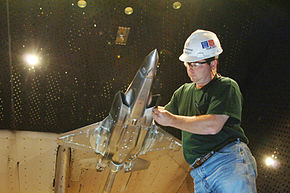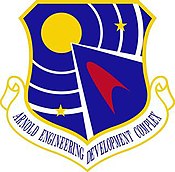

This article includes a list of general references, but it lacks sufficient corresponding inline citations. Please help to improve this article by introducing more precise citations. (February 2008) (Learn how and when to remove this message)
|
Arnold Engineering Development Complex | |
|---|---|

AnF-35 Lightning II Joint Strike Fighter model in the Arnold Engineering Development Center's 16-foot transonic wind tunnel
| |
| Active | 1950–present |
| Country | |
| Branch | |
| Role | Test facility |
| Part of | Air Force Test Center, Air Force Materiel Command |
| Garrison/HQ | Arnold Air Force Base, Tennessee |
| Nickname(s) | AEDC |
| Patron | Gen Henry "Hap" Arnold |
| Decorations | Air Force Organizational Excellence Award |
| Commanders | |
| Commander | Col. Grant A. Mizell |
| Insignia | |
| Arnold Engineering Development Complex emblem |  |
The Arnold Engineering Development Complex (AEDC), Arnold Engineering Development Center before July 2012, is an Air Force Materiel Command facility under the control of the Air Force Test Center (AFTC). Named for General Henry "Hap" Arnold, the father of the U.S. Air Force, AEDC is the most advanced and largest complex of flight simulation test facilities in the world.[1]
Headquartered at Arnold Air Force Base, Tennessee, the Complex also operates from geographically separated units at Ames Research Center, Mountain View and Edwards AFB, California; Peterson AFB, Colorado; Eglin AFB, Florida; the Federal Research Center at White Oak, Maryland; Holloman AFB, Kirtland AFB, and White Sands Missile Range, New Mexico; Wright-Patterson AFB, Ohio, and Hill AFB, Utah. AEDC operates more than 68 test facilities, including, but not limited to, aerodynamic and propulsion wind tunnels, rocket and turbine engine test cells, environmental chambers, arc heaters, ballistic ranges, sled tracks, centrifuges, and other specialized test units.[2]
AEDC conducts developmental testing and evaluation through modeling, simulation, ground, and flight testing. Testing aims to evaluate aircraft, missile, and space systems/subsystems at the flight conditions they will experience during a mission. The complex aims to be the best value U.S. ground test and analysis source for aerospace and defense systems.[3]
Several areas of the facility are contaminated by substances including polychlorinated biphenyls (PCBs) and volatile organic compounds and spills of jet and rocket fuel, chlorofluorocarbon solvents, nitric acid and other materials. PCBs from the site have been detected in local creeks, in the water, sediment and in fish.[4]
The site was proposed for addition to the Superfund National Priorities List in August 1994 though, as of May 2010, the site has not been added to the NPL.[5] The Environmental Protection Agency believes that human exposure to contaminants and contaminated groundwater migration are under control.[5]
The Air Engineering Development Center was authorized by an act of the 81st Congress, Public Law 415, approved 27 Oct. 1949 (Appendix 2).
On 7 March 1950, the Air Engineering Development Center was redesignated the Arnold Engineering Development Center (AEDC) effective 10 February 1950, per General Order #23, signed by then-Chief of Staff of the Air Force, General Hoyt S. Vandenberg. Arnold Engineering Development Center (AEDC) was later redesignated Arnold Engineering Development Complex (AEDC) on 6 July 2012.
The complex is a part of a master unitary wind tunnel plan that is designated to provide the testing "tools" required to assure the United States continued air and space supremacy.
The necessity for an aeronautical test complex of this type was recognized by a number of different agencies of the government, as well as by expert technical groups from the industrial-scientific world. The creation of these research and testing facilities has enabled the U.S. to stay abreast of developments in this fast-moving field.
AEDC is one of the most advanced and largest complex of flight simulation test facilities in the world with a replacement value of more than $7.8 billion.
At one time or another, the center has operated 58 aerodynamic and propulsion wind tunnels, rocket and turbine engine test cells, space environmental chambers, arc heaters, ballistic ranges and other specialized units. Twenty-seven of the center's test units have capabilities unmatched elsewhere in the United States; 14 are unique in the world.
Facilities can simulate flight conditions from sea level to 300 miles' altitude and from subsonic velocities to Mach 14.
AEDC's mission is to:
AEDC is an important national resource and has contributed to the development of practically every one of the nation's top priority aerospace programs, including better spacelift, aircraft, missiles and satellites. Many of these programs are highlighted in the following sections.
AEDC is an Air Force Materiel Command (AFMC) organization managed by the Air Force but operated largely by a contractor work force. While AEDC's primary location is in Tennessee, it also operates two geographically separated facilities—the Hypervelocity Wind Tunnel 9 in Maryland, and the National Full-Scale Aerodynamics Complex (NFAC), in California.
AEDC's economic impact to the local area for fiscal year 2008 exceeded $728 million. The total economic impact includes the center's payroll, secondary jobs created locally though the spending of that payroll, and other expenditures for supplies, utilities, fuel and services.
As a consultant to General Arnold, Theodore von Kármán first called for the Center:
The center operates more than 68 aerodynamic and propulsion wind tunnels, rocket and turbine engine test cells, space environmental chambers, arc heaters, ballistic ranges, and other specialized units. Currently, AEDC's prime contractor is the Aerospace Testing Alliance.
The center has helped to develop most aerospace systems in the U.S. government's inventory, including the Atlas, Titan, Minuteman and Peacekeeper ICBMs, the Space Shuttle, space station, and Projects Mercury, Gemini and Apollo.[12]
It is named for General Henry "Hap" Arnold, the father of the US Air Force and an air power visionary. The University of Tennessee Space Institute (UTSI) is located adjacent to AEDC.
The center lies near Manchester, Tennessee and Tullahoma, Tennessee, and occupies much of the site of the former Camp Forrest, a U.S. Army base and World War II POW camp. It is unique in that the majority of the workforce are contract personnel, with a small contingent of active-duty assigned.
"The Air Force Test Center (AFTC) started an organizational change process in 2015 to move some units within the AFTC from the 96th and 412th Test Wings over to the AEDC.[13] The largest change [was] the renumbering of the 96th Test Group as the 704th Test Group at Holloman AFB, NM. AEDC ..also [gained] the McKinley Climatic Laboratory at Eglin AFB, FL, and the Hypersonic Combined Test Force at Edwards AFB, CA." The changes took effect on 1 December 2016. It was planned to align "..most of the Air Force’s developmental ground test facilities under one commander, better fiscal synergy, especially in restoration and modernization funds, better balance in the span of control, and finally results in developmental opportunities for AFTC officers."
![]() This article incorporates public domain material from Arnold Engineering Development Center. United States Air Force.
This article incorporates public domain material from Arnold Engineering Development Center. United States Air Force.
![]() This article incorporates public domain material from the Air Force Historical Research Agency
This article incorporates public domain material from the Air Force Historical Research Agency
|
| |||||||||||
|---|---|---|---|---|---|---|---|---|---|---|---|
| Leadership |
|
| |||||||||
| Structure |
| ||||||||||
| Personnel and training |
| ||||||||||
| Uniforms and equipment |
| ||||||||||
| History and traditions |
| ||||||||||
| |||||||||||
|
| |||
|---|---|---|---|
| Air bases |
| ||
| Centers |
| ||
| Other |
| ||
35°22′44″N 86°03′00″W / 35.379°N 86.050°W / 35.379; -86.050